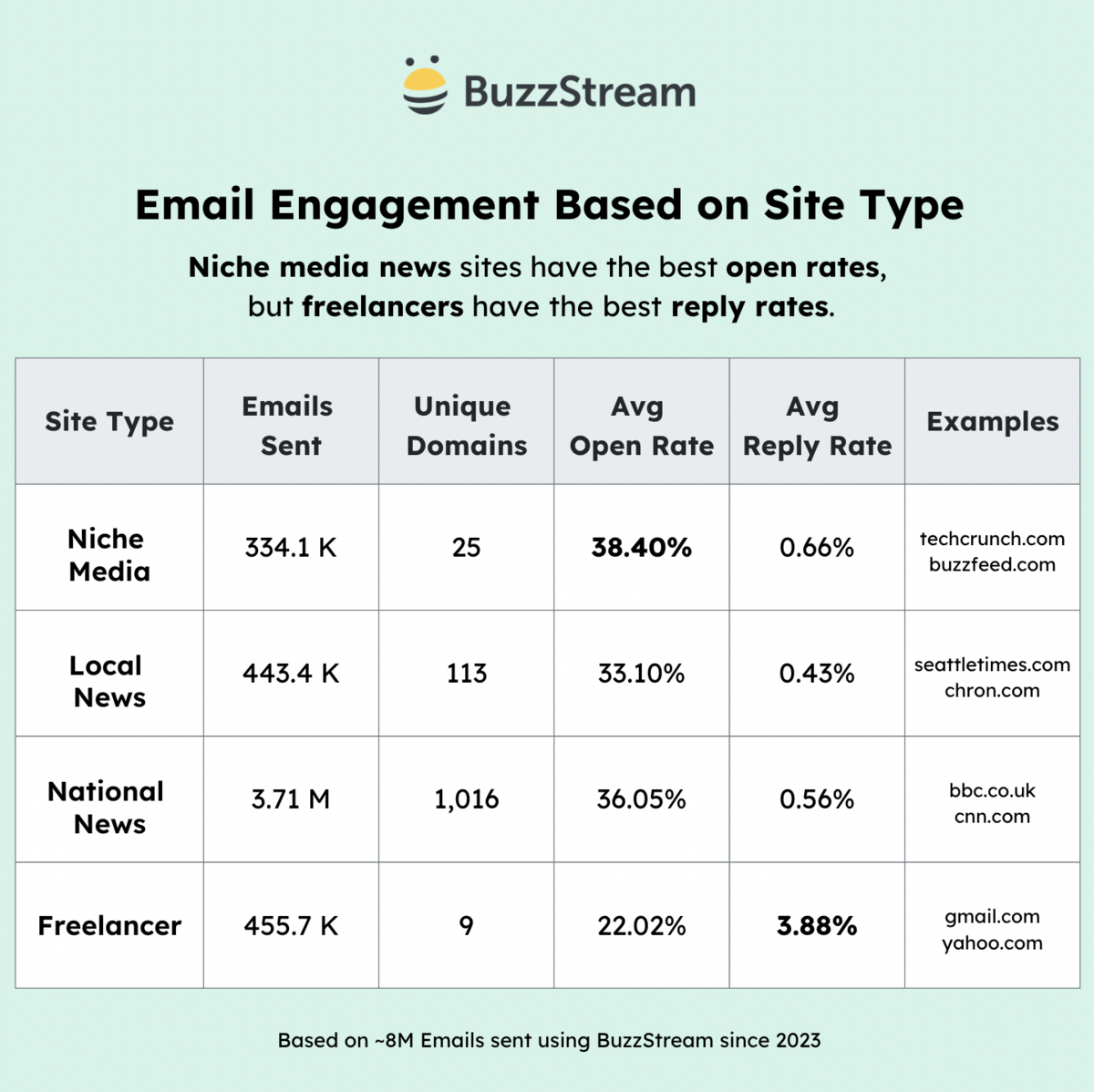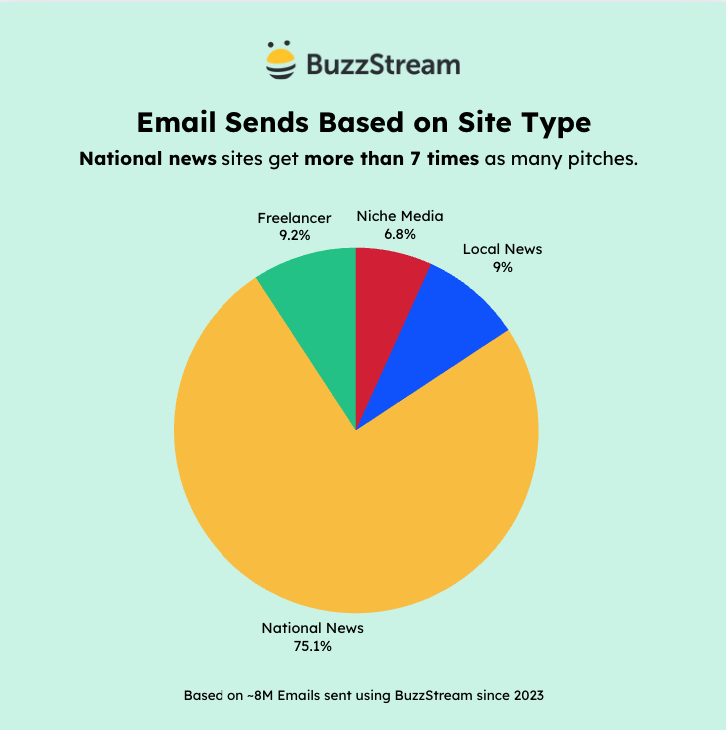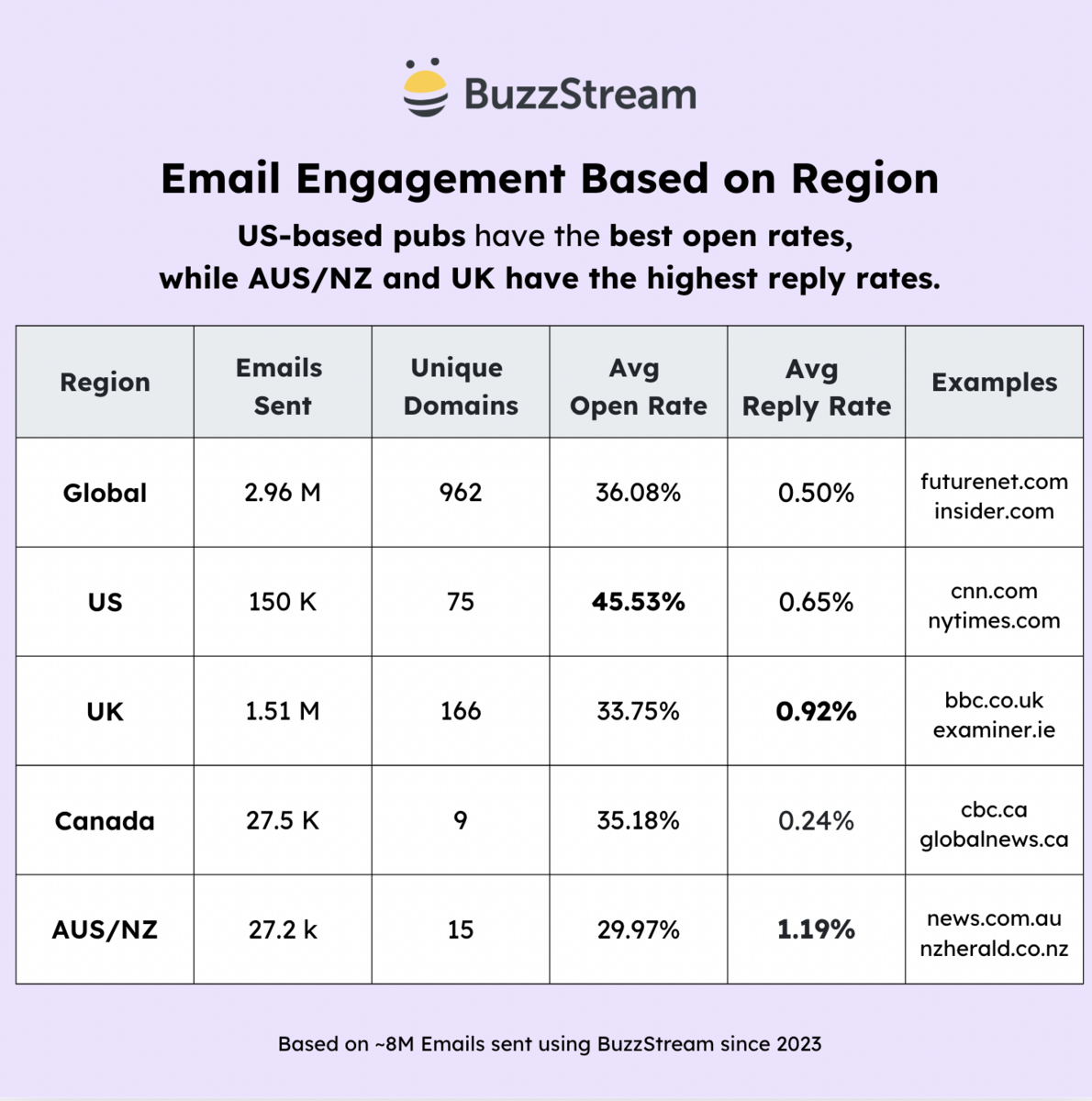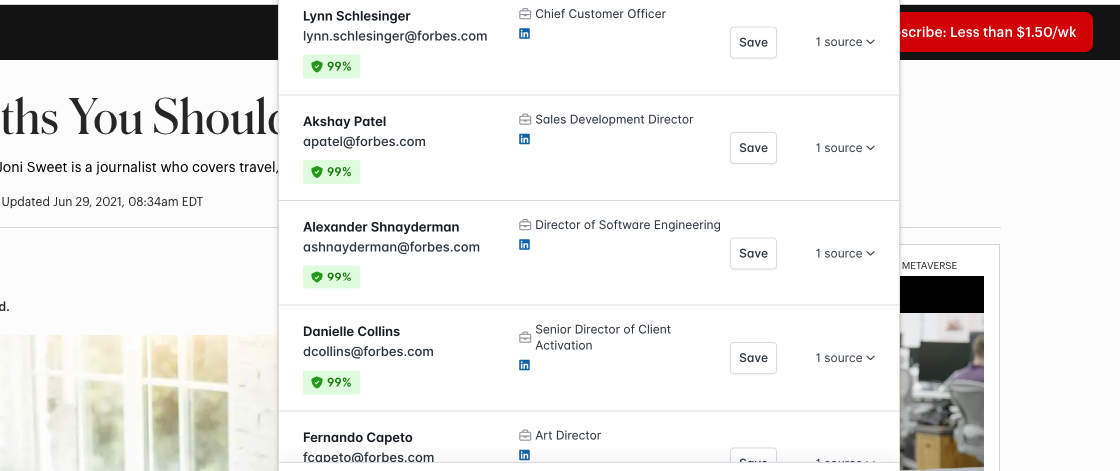Table of Contents
- Freelancer emails have low open rates but the highest reply rates, especially Gmail, at 4.88%.
- National news outlets dominate outreach but have lower engagement due to inbox saturation.
- Australian and UK journalists reply more often – local relevance and exclusivity increase success.
- US journalists open more PR emails, but UK journalists may source stories more creatively (e.g., TikTok, Reddit).
- Personal email addresses outperform, so use tools like ListIQ to help uncover them beyond standard pattern matchers.
Every digital PR pro has felt it.
Some emails vanish into the void, while others spark instant replies.
But is it random, or are certain types of sites just more responsive?
After analyzing over 8 million emails sent since the beginning of 2023 by our digital PR power users, I was able to track how different recipients engage with PRs.
Jump down to methodology and definitions.
Which Domains Get Emailed by PRs the Most?
Here is a breakdown of the top 50 domains in our list based on the number of sent emails.
| Recipient Domain | Sent Email Count | Open Rate (%) | Reply Rate (%) |
|---|---|---|---|
| gmail.com | 330,619 | 34.55 | 4.88 |
| reachplc.com | 219,098 | 31.70 | 1.11 |
| futurenet.com | 146,529 | 43.81 | 0.98 |
| newsquest.co.uk | 118,189 | 31.54 | 0.76 |
| the-sun.co.uk | 108,984 | 35.74 | 0.47 |
| hearst.co.uk | 96,451 | 40.73 | 0.25 |
| metro.co.uk | 94,583 | 42.53 | 0.22 |
| mailonline.co.uk | 83,085 | 44.96 | 0.57 |
| telegraph.co.uk | 81,397 | 37.81 | 0.32 |
| nbcuni.com | 79,540 | 19.33 | 0.33 |
| independent.co.uk | 78,197 | 45.18 | 0.20 |
| hearst.com | 74,469 | 38.03 | 0.23 |
| theguardian.com | 61,969 | 33.64 | 0.32 |
| condenast.co.uk | 55,930 | 43.29 | 0.33 |
| thesun.co.uk | 54,221 | 33.56 | 0.39 |
| jpimedia.co.uk | 53,703 | 30.19 | 0.80 |
| nationalworld.com | 52,125 | 36.95 | 0.84 |
| standard.co.uk | 48,954 | 41.13 | 0.39 |
| dailymail.co.uk | 47,045 | 41.48 | 0.37 |
| bbc.co.uk | 46,100 | 12.72 | 0.90 |
| bauermedia.co.uk | 43,255 | 64.79 | 0.89 |
| pa.media | 42,080 | 39.09 | 0.84 |
| hotmail.com | 42,067 | 16.15 | 1.17 |
| bizjournals.com | 40,422 | 55.95 | 0.72 |
| hellomagazine.com | 38,475 | 27.56 | 0.16 |
| inews.co.uk | 38,178 | 41.51 | 0.39 |
| fox.com | 37,905 | 35.47 | 0.29 |
| bloomberg.net | 36,269 | 15.77 | 0.46 |
| thetimes.co.uk | 35,336 | 35.64 | 0.47 |
| insider.com | 30,900 | 29.89 | 0.41 |
| huffpost.com | 30,572 | 27.90 | 0.25 |
| nytimes.com | 30,050 | 37.23 | 0.48 |
| ft.com | 30,035 | 41.98 | 0.59 |
| townsquaremedia.com | 29,639 | 54.42 | 0.30 |
| yahoo.com | 28,998 | 16.40 | 1.44 |
| ladbiblegroup.com | 28,944 | 52.38 | 0.49 |
| wsj.com | 28,691 | 48.25 | 0.91 |
| jpress.co.uk | 28,187 | 30.29 | 0.48 |
| nypost.com | 27,763 | 27.62 | 0.33 |
| condenast.com | 26,312 | 40.63 | 0.20 |
| gannett.com | 25,734 | 24.47 | 0.34 |
| abc.com | 24,561 | 11.30 | 0.14 |
| axios.com | 24,296 | 28.29 | 0.61 |
| businessinsider.com | 24,239 | 28.14 | 0.51 |
| timeout.com | 23,538 | 36.64 | 0.59 |
| mailonline.com | 22,540 | 52.85 | 0.61 |
| ap.org | 22,216 | 53.09 | 0.42 |
| buzzfeed.com | 21,740 | 28.19 | 0.28 |
| usatoday.com | 20,866 | 25.61 | 0.99 |
| washpost.com | 20,404 | 7.37 | 0.49 |
As you can see, recipients using Gmail dominate the list, (which we’ll see later may be indicative of freelancer use.)
Keep in mind that many of the top domains on this list (excluding Gmail) are part of large networks.
For instance, ReachPLC owns over 70 individual sites, but each journalist uses a @reachplc.com email address.
So, to get a better sense of the story, I’ve broken it down into site type.
Open and Reply Rates By Type of Site
We’ve broken these email domains into site types:
Niche Media – Publications that focus on specific industries or topics like tech news (TechCrunch, Wired), lifestyle sites (BuzzFeed, Hello Magazine), or vertical business journals (BizJournals, Retail Gazette).
National News
Large-scale, country-wide news organizations and major newspapers with broad reach across national or global audiences (e.g. FT, WSJ, BBC, Daily Mail).
Local News
Regional and community-focused newspapers, TV stations, and online hubs (Seattle Times, Arizona Republic, Newsquest titles, local TV affiliates).
Freelancer
I’ve grouped all personal email domains (Gmail, Yahoo, Hotmail) as freelancers.

Here is my main takeaway from the site type breakdown:
Freelancers Have Lowest Opens but Highest Replies
As you can see, the freelancer bucket is characterized by low open rates but high reply rates.
Here’s the breakdown:
| Domain | Emails Sent | Open Rate (%) | Reply Rate (%) |
|---|---|---|---|
| gmail.com | 330,619 | 34.55 | 4.88 |
| yahoo.com | 28,998 | 16.40 | 1.44 |
| hotmail.com | 42,067 | 16.15 | 1.17 |
| outlook.com | 17,189 | 21.61 | 1.61 |
| aol.com | 19,888 | 12.92 | 1.00 |
| me.com | 6,173 | 7.45 | 0.70 |
| live.com | 2,483 | 19.55 | 1.03 |
| icloud.com | 6,071 | 5.15 | 1.09 |
| protonmail.com | 2,257 | 64.35 | 0.27 |
As you can see, Gmail dominates with a reply rate of 4.88 and the highest number of emails sent at over 330K (keep in mind that Gmail is the most popular email provider), making it a true workhorse.
But why don’t freelancers open emails?
My one thought, based on my podcast conversation with Rosie Taylor, is that as a freelancer, her focus is much more divided than when she was in-house covering stories.
Aside from reading PR pitches, she also pitches to editors and bolsters her income through consulting, corporate training, and writing her own Substack newsletter, Get Featured.
But when you do catch a freelancer’s eye, they seem to be more interested in replying.
National News Pubs Get A LOT of Pitches
Technically, BuzzStream users send to more national news than other kinds of publications, but I think the fact that national news dominates so wildly tells the story beyond just BuzzStream.

Obviously, there are many more national news publications than local ones, but for PRs, this helps put into perspective what we face daily.
And as publications cut journalists from their roster, cutting through is getting more difficult. And as more link builders shift over to digital PR, there will be even more noise going to journalists.
Next, I wanted to examine the geographical breakdown to see if anything was interesting about how newsrooms around the world interact with PRs.
Open and Reply Rates Based on Region of the World
The regional breakdown is somewhat self-explanatory, but I wanted to mention that global sites do not have a clear country-code focus.
These are sites like BuzzFeed, Insider, and large aggregators.

Here are some of my takeaways:
AUS/NZ and UK journalists appear to respond the most
When compared to other regions, Australia, New Zealand, and the UK respond to emails more frequently than others. I reached out to a few experts in the space who I knew had a good background in Australian digital PR (and UK) to get some insights.
Former podcast guest, Ellie Sumner of Australia-based Prosperity Media, told me:
“When it comes to reply rates, I’ve consistently found them to be higher in Australia, too. Journalists here are more likely to get back to you if they’re interested, often wanting to collaborate, whether it’s arranging quotes from spokespeople, setting up interviews, or sourcing local case studies.”
Though she also told me that “Australian journalists are more likely to open emails that offer strong local relevance or exclusive angles.
Traditional reactive stories or generic pitches don’t tend to perform as well.”
Victoria Schmid, digital PR expert at KURU Footwear, told me that replies come from Australian PRs because they are looking for sources:
“When working in Aus, I found a lot of journalists who were interested in the story would reply asking us to find someone to interview or set them up with a source.”
Lastly, Amanda Walls, founder/director of digital marketing agency Cedarwood Digital, said,
“I would say that the Australian opens are super high because the Digital PR market is less diluted (so they are getting less press releases in their inbox).
We know that Digital PR is still very much in its infancy in Australia compared to the US/UK and is likely why the open rates are so much higher (simply a lower volume of overall emails).”
US open rates are higher than the UK
For some insights into the US vs UK, I spoke with Carrie Rose, founder and CEO of Rise at Seven.
“There are literally 10X more journalists in the US than in the UK.
UK journalists are time-strapped, producing high-volume stories, and therefore opening PR emails is more challenging for them.
In the US, however, more time and more of them, therefore, increases the average open rate.
UK journalists are a bit more ahead when it comes to where they get their stories, using TikTok, Reddit, or data to drive story ideas.
The US is still more reliant on PRs.”
I also reached out to Beth Nunnington, Global VP of Digital PR at Journey Further. She told me:
“It’s no surprise the UK sends more emails since journalists there produce more content daily. While a tailored approach is essential in both markets, it’s even more critical in the US, where a selective media landscape means pitches really have to stand out, which likely explains the higher open rates.
“The UK’s higher reply rate suggests outreach converts better in that territory, as journalists rely more on PR support to meet their publishing demands.”
It appears that a combination of workforce size and overall need for PR influences engagement rates.
So what does this all mean for PRs?
The Need to Find Personal Email Addresses
Really, the bigger takeaway for me is that there is an increasing need to cut through the noise.
And, given the fact that personal email addresses seem to have the best engagement rates, they are probably the best bet for PRs.
But finding them can be tough.
We observed in some earlier research that traditional email finder tools don’t perform well in uncovering journalist emails.
They are especially ineffective at uncovering personal email addresses because most of them are pattern-matching tools (i.e., they try to find the email pattern used by everyone at the target pub, like firstname@domain.com).
I’d recommend using ListIQ to help find personal emails because it only picks up verified addresses that it locates on the web, such as on journalists’ portfolio websites or social platforms.
For instance, say I wanted to reach out to the author of this Forbes article about yoga:

Email lookup tools have discovered those patterns:

But since the author is marked as a contributor, I know that she’s not a staff writer, so she’s not going to have an @forbes.com email address.
Instead, I add the URL to a Google Sheet and enable my ListIQ Chrome Extension.
Then I ask to add columns like bio and email address to the sheet, and ListIQ finds me the address, which happens to be a personal email address.

This is the kind of targeted approach that will become increasingly necessary to find the relevant journalists in 2025 and beyond.
Methodology
We only included campaigns with 25 or more emails and filtered out bounces and follow-ups. Only the top 10% of domains—those receiving 455 or more emails—were included in the final analysis, which lowered the overall number of sent emails to 4.9 M.

 End-to-end outreach workflow
End-to-end outreach workflow



 Check out the BuzzStream Podcast
Check out the BuzzStream Podcast







